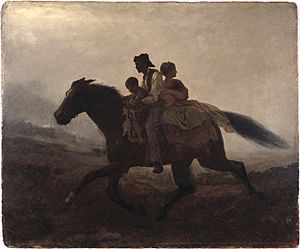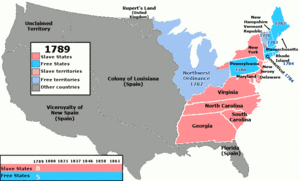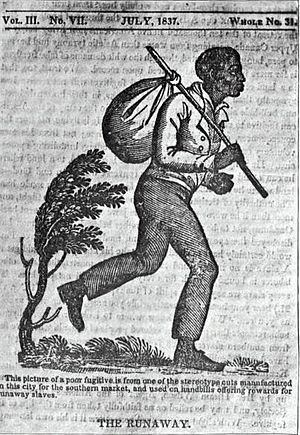Fugitive slaves in the United States facts for kids

In the United States during the 1700s and 1800s, people who escaped from slavery were called fugitive slaves or runaway slaves. Today, we often call them freedom seekers to show that they were not criminals, but people trying to gain their freedom.
These freedom seekers usually tried to reach places where slavery was against the law. This included states or territories in the U.S. where slavery was banned, or even other countries like Canada or Spanish Florida (before 1821). Most laws about slavery made it hard for enslaved people to travel. They had to carry special passes if they were not with their owners.
Later, a law called the Fugitive Slave Act of 1850 made the punishments much harsher for freedom seekers and anyone who helped them. Because of this, some freedom seekers left the United States completely. They went to Canada or Mexico. It's believed that about 100,000 American slaves found freedom this way.
Contents
Laws About Freedom Seekers
Laws about slavery started in Colonial America around 1643. These laws first appeared in the New England Confederation. Then, many of the original Thirteen Colonies passed their own laws. For example, in 1705, the Province of New York made a law to stop enslaved people from escaping north into Canada.

Over time, the states in the U.S. began to divide into "free states" (where slavery was illegal) and "slave states" (where it was legal). States like Maryland and Virginia offered rewards to people who caught and returned freedom seekers to their owners. By 1787, when the Constitutional Convention happened, five states had already ended slavery. These free states were New Hampshire, Vermont, Massachusetts, Connecticut, and Rhode Island.
The U.S. Constitution and Slavery
Lawmakers from the Southern United States were worried that free states would protect people who escaped slavery. The U.S. Constitution, which was approved in 1788, did not use the words "slave" or "slavery." However, it did recognize slavery in a few places. One part was called the fugitive slave clause (Article IV, Section 2, Clause 3). This clause said that freedom seekers had to be returned to their owners.
The Fugitive Slave Act of 1793
The Fugitive Slave Act of 1793 was the first federal law that allowed freedom seekers to be caught and sent back to their owners. Congress passed this law in 1793. It let slave owners and local governments, even in free states, track down and capture enslaved people. The law also said that anyone who helped freedom seekers escape could be fined $500.
Slave hunters needed a court paper to capture someone. Many people in the North thought this law was like legal kidnapping. They did not like the idea of slave hunters coming into their states. This law led to the creation of the Underground Railroad, a secret network of safe houses.
The Fugitive Slave Act of 1850
The Fugitive Slave Act of 1850 was a stronger law passed by Congress. It was part of the Compromise of 1850. This law said that all freedom seekers must be returned to their owners. The Southern states agreed to let California become a free state, and in return, the North allowed this new Fugitive Slave Act. The law was passed on September 18, 1850, and was finally canceled on June 28, 1864.
This act gave the federal government more power to catch freedom seekers. It even allowed federal marshals to force regular citizens in the North to help catch runaways. Many Northerners felt this law went too far. They believed it forced them to act against their beliefs that slavery was wrong. Because of this, many Northern states passed "personal liberty laws." These laws tried to prevent the kidnapping of people who were said to be freedom seekers. However, the Supreme Court later ruled that these state laws were unconstitutional. The court said that catching freedom seekers was a federal matter, meaning states could not interfere.
Many Northerners were very angry that helping people escape slavery became a crime. This law is seen as one of the main causes of the American Civil War (1861–1865). Both the Fugitive Slave Acts of 1793 and 1850 were canceled by Congress on June 28, 1864.
State Laws to Protect Freedom Seekers
Many states tried to stop the new federal slave act or protect freedom seekers. They did this by creating their own laws. A famous example is the Massachusetts Liberty Act. This law was passed to prevent federal marshals or bounty hunters from taking freedom seekers back to their owners. Wisconsin and Vermont also passed laws to get around the federal law. These actions made abolitionists, people who wanted to end slavery, even more involved in helping the Underground Railroad.
The Pursuit of Freedom Seekers
Advertisements and Rewards
When enslaved people went missing, their owners were often very angry. Many owners believed that slavery was good for the enslaved person. They thought that if someone ran away, it must be because Northern abolitionists had convinced them. One owner even said, "They are indeed happy, and if let alone would still remain so." Some even made up a fake mental illness called "drapetomania" to explain why a slave would want to run away.
Owners would put up posters, place ads in newspapers, and offer rewards to find freedom seekers. They would also send out groups of people to search for them. With the new Fugitive Slave Act, owners could send federal marshals into the North to bring people back. This law also brought in bounty hunters. These hunters would capture Black people, even if they were free, and claim they were freedom seekers to sell them back into slavery. For example, in 1851, a Black coffeehouse waiter was kidnapped by federal marshals. A man named John Debree claimed the waiter was his enslaved property.
Capture and Punishment
Freedom seekers who were caught often faced very harsh punishments. These could include severe whippings or branding.
People who helped freedom seekers were also charged and punished under the law. In a case called Ableman v. Booth, a man named Booth was charged with helping Joshua Glover escape in Wisconsin. Booth had stopped federal marshals from capturing Glover. The Wisconsin Supreme Court said the Fugitive Slave Act of 1850 was unconstitutional. They argued it forced states to break their own laws that protected people. However, the federal government appealed this case to the U.S. Supreme Court, which then said the Act was constitutional.
The Underground Railroad
The Underground Railroad was a secret network of Black and white abolitionists. It operated from the late 1700s until the end of the Civil War. This network helped freedom seekers escape to safety. Many religious groups helped run the Underground Railroad. These included members of the Religious Society of Friends (Quakers), the African Methodist Episcopal Church, Baptists, and Methodists.
In 1786, George Washington complained that a Quaker tried to free one of his enslaved people. In the early 1800s, Isaac Hopper, a Quaker from Philadelphia, and others in North Carolina set up a network of safe places. The term "Underground Railroad" became popular in 1831. That year, when Tice David was caught escaping from Kentucky to Ohio, his owner blamed an "Underground Railroad." Eight years later, a man named Jim, while being tortured for his escape, said he was going north along the "underground railroad to Boston."
Often, other enslaved people helped those who ran away. They would use secret signals, like lighting a certain number of lamps. Or they might sing a special song on Sunday. These signals let freedom seekers know if an area was safe or if slave hunters were nearby. If a freedom seeker stayed in an enslaved person's cabin, they would likely get food. They might also learn about good hiding places in the woods as they traveled north.
Hiding places were called "stations." These stations were set up in private homes, churches, and schoolhouses. They were usually in border states between slave and free states. John Brown had a secret room in his tannery. This room gave freedom seekers a place to stay on their journey. People who ran these stations provided food, clothing, shelter, and directions to the next "station." Often, freedom seekers had to travel through Southern slave states on their own to reach these stations.
The Underground Railroad stretched across the United States. It reached into Spanish Florida, Indian Territory, and the Western United States. It also extended into Canada and Mexico. At first, the Underground Railroad helped freedom seekers reach Northern states. But after the Fugitive Slave Act of 1850 was passed, it became a way to reach Canada. Canada was a safe place for African-American freedom seekers because it had ended slavery by 1783. Black people in Canada also had equal protection under the law.
The famous Underground Railroad "conductor" Harriet Tubman is said to have guided about 300 enslaved people to Canada. In some cases, freedom seekers even moved to Europe or the Caribbean islands.
Harriet Tubman: The "Moses of Her People"
One of the most famous freedom seekers and conductors of the Underground Railroad was Harriet Tubman. She was born into slavery in Dorchester County, Maryland, around 1822. As a young adult, Tubman escaped from her owner's plantation in 1849.
Between 1850 and 1860, she went back to the South many times. She led groups of other enslaved people to freedom. She knew the land well and used her knowledge to guide them. She helped hundreds of people, including her own parents, escape slavery. Tubman followed rivers that flowed north and used the North Star to find her way.
She liked to guide freedom seekers on Saturdays. This was because newspapers were not printed on Sundays. This gave her a one-day head start before "runaway" advertisements would be published. She also preferred winter because the nights were longer, making it safer to travel. Tubman wore disguises. She sang songs like Go Down Moses and Bound For the Promised Land in different ways. This told freedom seekers if it was safe to come out of hiding. Many people called her the "Moses of her people." During the American Civil War, Tubman also worked as a spy, a cook, and a nurse.
Notable People of the Underground Railroad
Many brave people gained freedom or helped others find freedom through the Underground Railroad. Here are some of them:
- Henry "Box" Brown
- John Brown (abolitionist), who later led a raid at Harpers Ferry. He had a secret room in his tannery for freedom seekers.
- Owen Brown, father of John Brown
- Elizabeth Margaret Chandler
- Levi Coffin
- Frederick Douglass
- Calvin Fairbank
- Thomas Garrett
- Shields Green
- Laura Smith Haviland
- Lewis Hayden
- Josiah Henson
- Isaac Hopper
- Roger Hooker Leavitt
- Samuel J. May
- Dangerfield Newby
- John Parker
- John Wesley Posey
- John Rankin
- Alexander Milton Ross
- David Ruggles
- Samuel Seawell
- James Lindsay Smith
- William Still
- Sojourner Truth
- Harriet Tubman
- Charles Augustus Wheaton
Communities for Freedom Seekers
Colonial America
United States
Civil War
- Camp Greene (Washington, D.C.) - A Civil War camp
- Theodore Roosevelt Island - A Civil War camp
Canada
- Africville - Nova Scotia
- Birchtown - Nova Scotia
- Dawn settlement - Ontario
- Elgin settlement - Ontario
- Fort Malden - Ontario
- Queen's Bush - Ontario
See also
 In Spanish: Esclavos fugitivos en los Estados Unidos para niños
In Spanish: Esclavos fugitivos en los Estados Unidos para niños
- Abolitionism
- Maroon (people), African refugees who escaped slavery and formed their own communities
- Slave Trade Compromise and Fugitive Slave Clause


